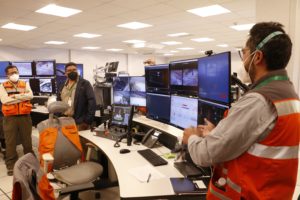BHP is one of the most experienced global miners in terms of fully autonomous blasthole drilling, now with a large fleet and having used both new autonomous machines as well as retrofitting older models in the Pilbara going back some years across its Western Australia Iron Ore (WAIO) operations – most recently at South Flank but also Newman East (Eastern Ridge), Newman West (formerly Mt Whaleback), Yandi, Mining Area C and Jimblebar. These projects have all been carried out with drill OEM and autonomous drilling major Epiroc, beginning with trials at Yandi that began in 2014. In the Pilbara this has mainly involved Pit Viper 271 units but more recently also the SmartROC D65 at South Flank.
Moving to Latin America, BHP is now in the process of rolling out autonomous drilling at Escondida and Spence – and at Spence officially began operating its first autonomous blasthole drill on December 1. Spence is a copper open pit operation located in Antofagasta Region, northern Chile, and BHP told IM that the plan envisages the commissioning of five autonomous drills, which will gradually be incorporated into the operation in the coming months. In the future, it is expected that 100% of Spence’s drill fleet will be operate autonomously. The Spence autonomous drills are Pit Viper 351 models being monitored from a control room in Spence, 2 km from the open pit.
BHP stated: “This implementation allows us to reduce the exposure of people to operational risks of health and safety, while the equipment’s availability is expected to increase by 1.7% and utilisation will increase by 14.1%. Autonomous drill operation marks the beginning of a journey towards broader autonomy that is underway in Spence. It is also expected for the operation and BHP to decide on the truck fleet’s autonomy during 2022.”

The Spence drills are equipped with RCS 5, the latest version of Epiroc’s Rig Control System. It provides a number of safety and interlock features, as well as a foundation to add new functionality/options later without a major rebuild of the machine. As an example, a new Drilling Data Screen in RCS 5 features real time depth monitoring and creates a penetration rate histogram so controllers can easily monitor what’s happening in the hole. Machines operating on the same pattern can share real-time updates of the progress each drill is making against the drill plan.
This path to autonomy was a two-year process in which different BHP areas and functions participated along with the asset’s teams. The transition to autonomy in drills at Spence has required the creation of 16 new roles – for example, Autonomous Drill Controllers and Autonomous Drill Yard Operators. Spence opened 16 new positions, which were filled internally following an open recruitment and selection process. “To fill these positions, BHP made an open call to all of its workers to apply for the new job positions. There was significant interest: the company received close to 100 applications. The workers selected received specialised training, a total of close to 200 hours of theoretical and practical training. The process considered broad-based dialogue with workers. First, through ongoing discussions with union leaders and next, through early conversations with operators and supervisors involved in the process.”
In November 2021, Spence as well as Escondida and Olympic Dam in Australia, were awarded the Copper Mark certification for responsible production practices after an independent assurance process.











